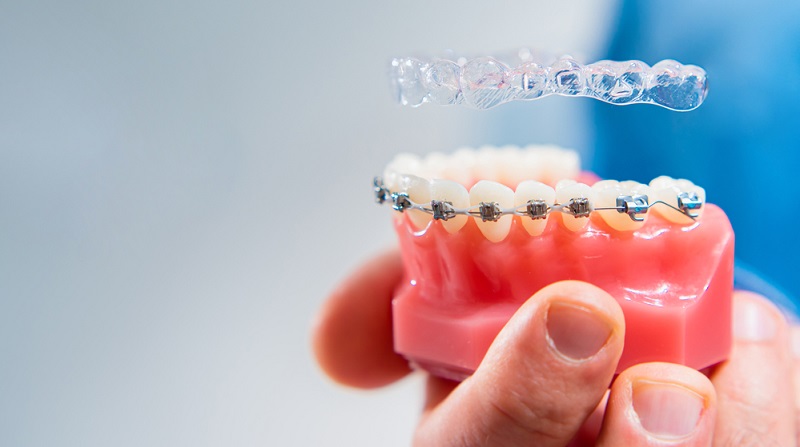What are the Pros and Cons of Aligners and Braces?
Contents

Are you considering orthodontic treatment to straighten your teeth? Still, confused between aligners or braces? Can’t decide which is the best option for you?
If so, then you are at the right place! This article will explore various aspects like the differences between aligners and braces in terms of cost, timeframe, comfort level, and more.
So if you have been looking for a comprehensive guide to help make an informed decision about which one is right for you –don’t waste time and just read on!
What are Aligners & Braces?
Braces and aligners are two orthodontic procedures used to realign mismatched teeth and jaws. Aligners are clear, flexible plastic devices that fit tightly around your teeth like a retainer.
They are removable, so you may remove them to eat or brush your teeth. They function by gradually moving your teeth into the proper alignment over time.
Braces, on the other hand, are made up of brackets that are attached to each tooth and are held together by wires and elastic bands.
Braces, unlike detachable aligners, must be worn for 6 to 30 months, depending on the treatment plan suggested by an orthodontist.
Braces exert consistent pressure on your teeth, causing them to shift into appropriate alignment over time.
Both aligners & braces have resulted in showing effective ways of correcting misaligned teeth and jaws with great results if worn correctly and consistently as prescribed by your orthodontist.
Pros and Cons of Aligners
Aligners are a popular orthodontic treatment used to help straighten teeth and improve the overall look of your smile.
While aligners are an effective way to achieve desired results, they do come with some pros and cons that should be taken into consideration before committing to them.
Pros of Aligners
- One of the major pros of using aligners is that they are less invasive than traditional braces.
- Aligners can be removed for eating, drinking, brushing, and flossing, which eliminates food being trapped in brackets or wires causing tooth decay or bad breath.
- They also don’t require trips to the dentist for adjustments so you can save money on regular visits.
- Additionally, many people find them more comfortable than traditional braces since there is no metal in contact with the mouth or gums.
Cons of Aligners
- On the other hand, one of the downsides of aligners is that they must be worn for at least 22 hours per day to work properly. This means you need to develop the discipline of wearing them regularly.
- As well as this, although aligner treatments generally take shorter periods than those with traditional braces (6-12 months), it will still take several weeks before any visible changes start taking place; therefore requiring patience throughout the process.
- On the contrary, when deciding whether or not aligners are right for you it’s important to weigh up both their advantages and disadvantages carefully before making a decision.
- While they can provide excellent results without needing frequent dental visits or dealing with uncomfortable metal hardware - there is also less room for error due to having less control over how often patients wear them compared with traditional braces.

Pros and Cons of Braces
Anyone who has experienced dental concerns with tooth alignment and crowding has the worry of braces making them look much worse.
But it's also not all that horrible. It's a band-aid for long-term happiness. After a few months of discipline, pain, and adjustment, you'll have the ideal smile you've always desired.
Braces are a popular approach to straightening teeth and correcting uneven bites. They can assist people in achieving a more beautiful smile, but as with everything, there are some downsides.
Here's a rundown of the benefits and drawbacks of braces.
Although braces perform the same function as dental aligners with less discomfort, this option is just right for those who do not want surgery and want to straighten their teeth over some time.
Pros of Braces
- The most significant benefit of braces is that they can significantly improve your smile and correct any dental problems caused by misaligned teeth or jaw difficulties.
- Straight teeth are easier to clean and maintain, resulting in greater long-term oral health.
- Orthodontic therapy not only improves appearance, but it may also help alleviate facial pain caused by TMJ disorders or an incorrect bite.
Cons of Braces
- Braces, on the other hand, necessitate frequent visits to the orthodontist for modifications, as well as daily brushing and flossing to keep them clean.
- Braces can be uncomfortable for the first few weeks after they are installed due to their tightness around the teeth and mouth.
- Furthermore, you'll need to be especially cautious about what foods you eat because certain items, such as popcorn kernels and sticky confectionery, can become caught beneath brackets or between wires.
Conclusion
Overall, wearing both aligners and braces has definite advantages if you desire a straighter smile that looks fantastic and operates well! It is ultimately up to you if braces will fit into your lifestyle.
Even after analysing the benefits and drawbacks of both braces and aligners, if you're still undecided, why not try Dezy?
We make dentist appointments easier and less stressful with Dezy's at-home consultations. Your doctor pays you a home visit and examines your teeth.
You pay once they have reviewed the scans and developed the treatment or therapy you require, and you are completely confident in your teeth straightening journey.
Following that, you will receive your Dezy teeth straightening kit, which includes everything you need to get started.


